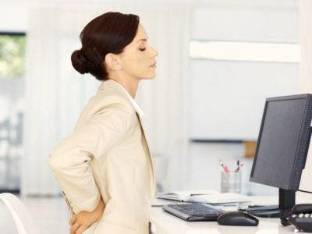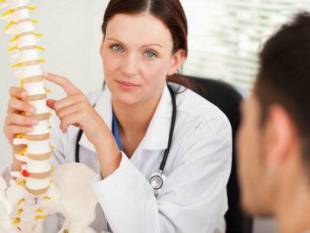If the person has pain in the back, in the lumbar region, the reasons can be different up to the kidney pathology. Most often this symptom is taken by diseases of the lumbosacral region of the spine. Lumbar is the mobile that it is the most common cause of injury in precisely this area.
Why are you developing the pain syndrome?

The pain in the back — it is only a symptom. Acute low back pain related to an infringement of work of the lumbar vertebrae and discs, called lumbago. Why the back pain in the background, all the world should know. There are the causes of the occurrence of this symptom:
- osteochondrosis of the lumbosacral region of the spine;
- a hernia between vertebrae;
- Ankylosing spondylitis;
- a slip of the vertebra;
- birth defects (presence of a position of the lumbar vertebra, the split of trip);
- innate of the violation of the form of the vertebrae;
- neoplasms benign, malignant and vascular tumors;
- rheumatism;
- inflammation of muscles (myositis);
- the inflammation of the sciatic nerve;
- fracture of the vertebral column;
- spondylolisthesis;
- osteomyelitis;
- fibrotic;
- osteoporosis;
- protrusion of the disk;
- narrowing of the spinal canal;
- osteoarthritis;
- diseases of kidneys (hydronephrosis, pyelonephritis, tumor).
The spine in the lumbar region may be hurt by the simple muscle spasm. It may be in the case of rotation or of the execution of the exercise. The back pain in the lumbar region is most common among people who lead a sedentary lifestyle and raise the severity. Among people practicing sports, this condition is much less frequent.
Sciatica low back pain
If you still have trouble at the bottom of the back of the back, it may be a manifestation of the degenerative disease of disk lumbo-sacral spine. This disease, which mainly affects the discs between the vertebrae. They are thinner, which leads to friction between them and a decrease of the mobility of the disc. There are the factors predisposing the development of this disease:
- stay for hours in an uncomfortable position;
- long slopes of the trunk;
- a lack of training in physical education;
- the weakness of the muscles and ligaments of the back;
- wear backpacks on 1 of the strap;
- the presence of flat feet;
- a physical work;
- the largest of the static loads;
- the poor organization of the space.
Back pain is the main symptom of the degenerative disease of the disc. 1 the extent of the disease, the pain syndrome is absent. With the development of the protrusion of the disk develops lumbago. It is suddenly appear pain in the lower back. Some people feel like an electric shock. It appears during sudden change of posture, or of the conduct.
If the back pain in the lumbar region, the cause may be lumbodynia. This is the pain chronic low back pain. Its appearance does not depend on the motor activity of man. The pain is dull. These people difficult to bend the body. In the position of the man lying on his back, the pain syndrome disappears or decreases.
Osteochondrosis 3 degree develops radicular syndrome. It manifests itself lumborum ischialgia. It is the pain, which gives the lower limb through to toes. Often, it goes with the violation of the sensitivity. The discomfort in the lumbar region due to compression of nerves, blood vessels, and muscle spasms.
Symptoms of hernia

If he is concerned about the pain in the lower back, the reasons may also be caused by intervertbral hernia. This disease very common. If the nucleus of the disc, the femur moves. Often, in this context, there is a rupture of the fibrotic ring. The morbidity rate is 150 cases per 100 thousand people. Secrete the reasons for the formation of the hernia:
- injuries (bruises, falling);
- osteochondrosis of the lumbosacral region;
- excess weight;
- the curvature of the spine;
- of tight turns.
In the group of risk includes the drivers and office employees who work at the computer. The pain hernia has the following characteristics:
- is local;
- often, in the thigh, buttock and shin;
- associated with other symptoms (numbness, tingling);
- enhanced by physical activity.
The severity of the pain is determined by the hernia. If it is big, it can develop sciatica. It is manifested by sciatica. It is a pain in the form of lumbagoes.
Most of the patients with hernia develops a type of pain lumbago. Other symptoms of the hernia is the reduced power, reduced mobility, lumbar spine, weakness in the legs. Sometimes violated the urination.
The symptoms of ankylosing spondylitis
When the back pain in the sacral region and the lower back for a while, you can suspect the disease of Ankylosing spondylitis.
It is a chronic disease, a systemic disease, which is most often affects the joints of the spine. The exact causes of development of this disease are not installed. Excrete the causative factors:
- inflammation of the genito-urinary organs;
- hypothermia;
- the injury of the bone;
- prdisposition hrditaire;
- the infection.
Ankylosing spondylitis occurs mainly in young people aged 15 to 40 years. This pathology manifests itself with joint and articular symptoms. The pain in the back and stiffness of the spine are an early symptom. The pain is felt in the sacred department. In the early stages, it are mild. Its appearance is due to inflammation.
The pain is bilateral. A lot of people point out that the syndrome of the most severe pain that a side. It lasts for more than 3 months and does not pass. The disease develops very slowly. The pain is painful these people mainly in the morning. Perhaps its appearance after a static load.
At mid-day, it decreases. Syndrome the pain intensifies in a state of rest and disappears on the job. In a phase of strong pain occurs during the night and during the work. During later stages develops sciatica. The pain syndrome in the disease of Ankylosing spondylitis is combined with the deterioration of the overall health of the man, by stress in the chest, shortness of breath, if the head, pain in the muscles of the chest. Often affects the eyes.
The kidney disease

If the bad back-to-back, may be the cause of the renal disease (hydronephrosis or pyelonephritis). The buds located retroperitoneal. In case of inflammation (pyelonephritis) back pain is the most frequent complaint of patients. This disease is often detected in children and young girls. Pyelonephritis often develops in the background of nephrolithiasis.
The disease is contagious in nature. The most vivid flowing acute pyelonephritis. It is characterized by pain in the lower back, nausea, fever, chills, weakness, malaise, frequent urination. Often appear the swelling. The pain is most often unilateral, dull, and permanent. The Irradiation possible in the area of the hypochondrium, lower abdomen and the navel.
If there was pain in the lower back, the reasons may also be caused by hydronephrosis. This disease, which is an extension of the renal calyx and pelvis. Often, this pathology develops in young children. The development of hydronephrosis is the violation of outflow of urine, the poor functioning of valves and obstruction of the urinary tract.
When the hydronephrosis appears a sharp pain in the back. It is irradiating. It occurs in the side just above the pelvic bone. The pain is paroxysmal, reminiscent of renal colic. The syndrome of the pain is combined with nausea, vomiting, the appearance of blood in the urine.
The events during the sciatica
If it hurts the spine in the lumbar region, it may be an inflammation of the sciatic nerve. This condition is called the sciatica. In the risk group are the elderly. Sciatic pain (sciatica) often develops on the background of intervertbral hernia, infectious diseases (influenza, malaria, tuberculosis), degenerative, intoxication. Often, the sciatic nerve may occur in pregnant women.
The pain of sciatica is has the following features:
- acute (dagger);
- permeates;
- intense;
- of the furnace or the shooting;
- initially, appears at the bottom of the back, then descends (descending nature);
- extends to the buttock, the thigh and the tibia;
- of concern constantly in the form of crises;
- has a different power;
- the more often one-sided.
The pain is accompanied by tingling, numbness and motor mental disorders. Other symptoms of sciatica refers to muscle atrophy, the violation of the sweating, the dryness and thinning of the skin.
Plan of examination of patients
Not everyone knows what to do if the back pain in the lumbar region. You must consult your doctor for an examination. May need to research the following:
- ct scan;
- the x-ray of the lumbosacral region of the spine;
- An ULTRASOUND of the kidneys;
- magnetic resonance imaging;
- electroneuromyography;
- - doppler imaging of the vessels;
- general and biochemical analysis of the blood;
- the analysis of the urine;
- cystourethrography.
Necessarily performed the inspection and palpation of the lumbar region and the spine. Requires the consultation of a neurologist or vertebrologist. During the examination, the doctor assesses the mobility of the spine, reflexes, muscle strength, range of motion in the limbs. Almost always the cause of low back pain are diseases of the spine. Their easy to identify on the photo.
Therapeutic measures

If the back pain, the treatment must target the main cause of the pain. Methods of treatment:
- the system of drug treatment;
- the use of analgesics in the form of gels and ointments;
- physiotherapy;
- manual therapy;
- acupuncture;
- the blockade;
- the surgical treatment;
- PHYSIOTHERAPY.
These patients need to do gymnastics and to adhere to a diet rich in protein. Tasks in the course of the year must have a large amplitude. If the low back pain is a sign of pyelonephritis, it is necessary to comply with bed rest, take pain medication and antibiotics. When chronic inflammation additionally appointed diuretics. Antibiotics preferably ftorhinolonam and penicillins.
Also appointed immunomodulators and vitamins. In the case of a developing hydronephrosis may require surgical treatment. When the pain on the bottom of the sciatic apply analgesics (Analgin), a combination of means, the NSAIDS. In severe cases require novocaine blockade. In the scheme of treatment which include massage, gym, acupuncture.
In order to eliminate the pain can be distracting therapy. Apply an ointment of bee or snake venom. Hernia view the NSAIDS, stretching of the spinal column, massage, and gymnastics, medical. In severe cases, surgery is necessary. When the pain in the bottom of sciatica treatment involves immobilization of the spine, the application of analgesics and the introduction intramuscular injection of anesthetics. Also called the vitamins of the B group (Combilipen).
Effective and physiotherapy. Upon detection of the degenerative disc disease shown physiotherapy, massage, receiving pain medication, PHYSIOTHERAPY. Necessarily appointed chondroprotectors. Thus, the patient is in need of more moving and less time standing or sitting. In the scheme of treatment include manual therapy and the blockade. Therefore, the onset of pain in the low back is the reason for the treatment at the hospital.


























